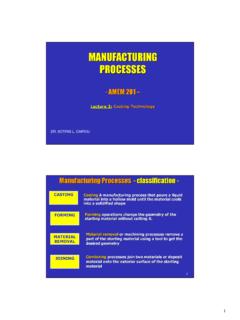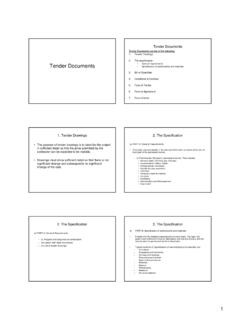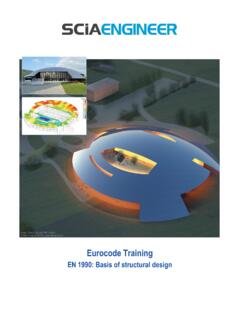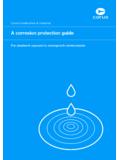Transcription of CONNECTIONS IN TIMBER STRUCTURES - FIT
1 CONNECTIONS Page 1 of 17 30/01/2006 CONNECTIONS IN TIMBER STRUCTURES Introduction The competitiveness of a TIMBER structure , relative to other building materials, may be determined by the efficiency of the CONNECTIONS . In most cases the fastening of TIMBER to TIMBER requires little skill or knowledge of design. Consider the widespread use of nails in domestic situations where the handyman routinely uses nails and bolts to construct all manner of TIMBER STRUCTURES . In heavy construction, joints may require ingenuity and the use of specialized connectors, such as nail-plates, bolts, shear-plates, split rings, coach screws or glued-in threaded rods. The application of these requires some knowledge of design and construction skills. The shrinkage and swelling characteristics of TIMBER in response to drying and wetting, the possibility of fungal decay in the presence of moisture and the need to protect metallic fasteners from fire or corrosion, call for special construction detailing.
2 Factors affecting the detailing of CONNECTIONS . Changes in moisture. Changes in the moisture content of the TIMBER will cause the TIMBER to swell and shrink. The dimensional changes in the direction parallel to the grain can be ignored in most cases. The dimensional change in the perpendicular-to-grain direction can be large, especially if the moisture content variation is large. This must be borne in mind when a horizontal TIMBER member is connected to a vertical TIMBER or steel member. If the connectors prevent shrinkage, splitting of the TIMBER may occur. This type of splitting often occurs when treated TIMBER , which generally still has a high moisture content, is bolted to uprights. Figure 1 shows how the TIMBER may split when movement is prevented. The splitting of the TIMBER at the support may reflect negatively on the shear strength of the member. Figure : Splitting of TIMBER as a result of differential shrinkage.
3 In the case of the connection in Figure 1, it would have been preferable to install only one larger connector. Perpendicular-to-grain tensile strength The drinking straw analogy for TIMBER works well when one is designing CONNECTIONS . Remember that the adhesive sticking the straws together is weak. Any connection, which tends to cleave the wood, will of necessity be weak. Figure 2 illustrates the loads that can cause cleavage as a result of tensile loads perpendicular to the grain. If this type of connection cannot be avoided, it is always good policy to move the bolt down as far as possible. CONNECTIONS Page 2 of 17 30/01/2006 Figure : Loading of member in tension. Cracking may occur when end distance is insufficient. Cleavage often occurs in trusses where one of the chords, , top compression member or bottom tie, has to transfer the loads between the web members and the web members are some distance apart.
4 Figure 3 shows such a cleaving action. Figure : Cleaving of member as a result of tension perpendicular to the grain. Shear strength The horizontal shear strength of TIMBER is low, typically one tenth of the bending strength. This can cause problems when there is an eccentricity between the loaded point and the support. This is aggravated when the loaded point has damaged the supporting member, by for instance, a bolt hole. The effective shear transfer area is greatly reduced at the bolt hole. Figure 4 shows an eccentrically loaded support for a truss. Note that the bolt hole is in an area of large shear as well as bending stress. The high stresses at these supports must be borne in mind, when designing the truss. Figure : Shear force and bending in member as a result of an eccentric connection and support. CONNECTIONS Page 3 of 17 30/01/2006 Selection of Fasteners. Mechanical fasteners A mechanical fastener is any device, metallic, plastic or TIMBER , which transfers load from one piece of TIMBER to another piece of TIMBER .
5 The most common types of fasteners are metallic and include: Nails Dowels Screws Bolts Coach-screws Toothed ring connectors Split rings Nail plates Proprietary or patented fasteners. Most fasteners transfer forces through bearing on the TIMBER and shear in the connector. Screws may under certain circumstances be used in withdrawal, although end grain withdrawal is not recommended. Fastener strength The strength of the various fasteners, together with end and edge distances is given in SABS 0163. SABS 0163 does not give strength values for proprietary or patented fasteners. Strength values for these must be obtained from the manufacturers literature. Structural efficiency Structural efficiency can be described as the load that can be transferred divided by the area required by the connectors. It can be shown that nails or dowels into pre-drilled holes through steel plates, are the most efficient connectors.
6 These are followed by bolts, toothed-ring connectors and split rings. Nails in pre-drilled holes are in the region of twice as efficient as any of the other connectors. In terms of cost efficiency, bolts may be cheaper than nails. The choice of connector will depend on the available space for the connection and the esthetics. End-grain connectors, where the load transfer is through direct tension, are the most efficient connectors. The shorter the load path can be made, the more efficient the connector becomes. Glued-in threaded rods may be used to obtain very efficient CONNECTIONS . Figure : Bolted connection showing the convoluted load path for the transfer of the forces. CONNECTIONS Page 4 of 17 30/01/2006 Figure : Shortened load path when glued-in rods are used. Designing for durability Irrespective of the fastener type, a joint should be designed and constructed for durability.
7 The durability of TIMBER STRUCTURES is influenced by a number of factors. Fungal decay Decay or fungal attack is the result of the action of fungi, which break down the chemical structure of TIMBER if suitable conditions prevail. A combination of the following circumstances creates such suitable conditions: The moisture content must be higher than 20%. It is unusual for this to happen except where TIMBER is exposed to rain, TIMBER is in direct contact with trapped water or placed directly in the ground. Fungal attack may also occur in the following: inadequately ventilated swimming pool STRUCTURES , bathrooms, laundries, under-floor areas, saunas, cooling towers as well as bridge and pier STRUCTURES close to the water. Oxygen must be present even in small quantities. TIMBER will not decay if permanently immersed in water. The temperature must be in the range of 5 C to 40 C. Above and below this temperature range, decay virtually ceases.
8 The optimal temperature range for fungal growth is 25 C to 35 C. The TIMBER on which the fungal lives must be either naturally or chemically unprotected. End-grain is especially susceptible to the ingress of moisture and this is where decay usually begins. Other TIMBER Hazards TIMBER that is exposed to high levels of ultra-violet radiation, rain and extremes of temperature can suffer from splits, cracks and discolouration. It can also be subject to insect attack and marine borers. These factors do not affect the calculations of the design but must be borne in mind, when the connection is being detailed. Joint Detailing Principles To achieve good joint design and structural detailing, the following general principles should be observed: Avoid CONNECTIONS that can trap moisture. Ensure proper drainage and ventilation of especially the end-grain. Avoid exposing unprotected TIMBER to the weather.
9 If capping is used, ensure that all the moisture can escape and that the capping is properly ventilated. Capping that leaks and is not ventilated will hasten the onset of and promote fungal decay. Avoid placing especially the end-grain of TIMBER in direct contact with concrete. Concrete is hygroscopic and will increase the moisture content on the interface between the concrete and the TIMBER . If possible leave an air gap between the TIMBER and the concrete. If the TIMBER cannot be supported away from the concrete, insert a steel plate between the TIMBER and the concrete. The steel plate will act as a moisture barrier. If moisture can enter at bolt holes, treat the TIMBER in the hole with a preservative that does not leach out. If leaching is a problem, the bolts can be covered with a grease or a silicon sealant. Use chemically treated TIMBER where moisture ingress could be a problem.
10 Remember that CCA treatment stops fungal decay but not swelling and shrinkage due to moisture ingress. Always treat TIMBER with an additional water-repellant. Corrosion resistant fasteners should be used in salt-water or seaside environment. Corrosion resistance in ascending order: steel, aluminium , stainless steel, copper and copper alloys. Where possible, transfer forces through direct bearing, thereby shortening the load path. In coastal areas, large diameter bolts may be used, where a certain percentage of the area is sacrificial and the bolt maintains enough strength after corrosion has taken place. Bituminous or epoxy coating can improve the performance of bolts. Hot-dipped or electro-plated zinc coated bolts may be used in STRUCTURES where a high chemical hazard exists. CONNECTIONS Page 5 of 17 30/01/2006 Some Practical Joint Details Figure : A method of avoiding splitting as a result of large tension perpendicular to the grain.
















